check engine Ram ProMaster City 2020 Owner's Guide
[x] Cancel search | Manufacturer: RAM, Model Year: 2020, Model line: ProMaster City, Model: Ram ProMaster City 2020Pages: 350, PDF Size: 13.27 MB
Page 201 of 350

198 STARTING AND OPERATING
(Continued)
CAUTION!
• Always check the depth of the standing water before driving through it. Never drive through standing water
that is deeper than the bottom of the tire rims mounted
on the vehicle.
• Determine the condition of the road or the path that is under water and if there are any obstacles in the way
before driving through the standing water.
• Do not exceed 5 mph (8 km/h) when driving through standing water. This will minimize wave effects.
• Driving through standing water may cause damage toyour vehicle’s drivetrain components. Always inspect
your vehicle’s fluids (i.e., engine oil, transmission, axle,
etc.) for signs of contamination (i.e., fluid that is milky
or foamy in appearance) after driving through standing
water. Do not continue to operate the vehicle if any
fluid appears contaminated, as this may result in
further damage. Such damage is not covered by the
New Vehicle Limited Warranty.
• Getting water inside your vehicle’s engine can cause it to lock up and stall out, and cause serious internal
damage to the engine. Such damage is not covered by
the New Vehicle Limited Warranty. CAUTION!
(Continued)
2020_RAM_PROMASTER_CITY_OM_USA=GUID-7B6A7FCA-79B0-423F-95C5-ED2A949C3D13=1=en=.book Page 198
Page 232 of 350
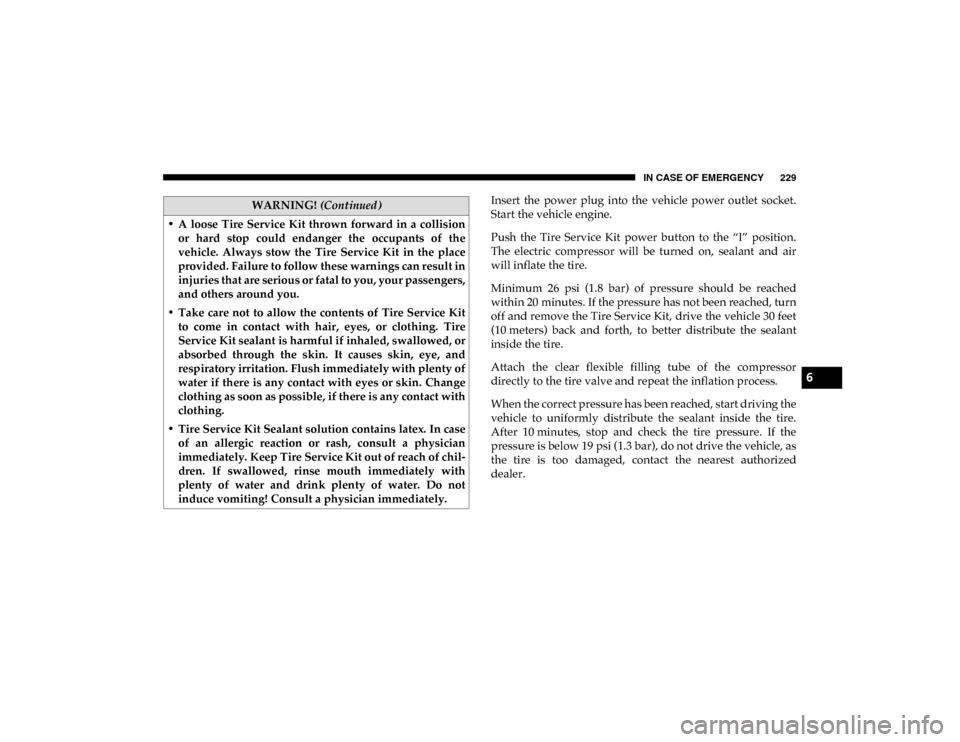
IN CASE OF EMERGENCY 229
Insert the power plug into the vehicle power outlet socket.
Start the vehicle engine.
Push the Tire Service Kit power button to the “I” position.
The electric compressor will be turned on, sealant and air
will inflate the tire.
Minimum 26 psi (1.8 bar) of pressure should be reached
within 20 minutes. If the pressure has not been reached, turn
off and remove the Tire Service Kit, drive the vehicle 30 feet
(10 meters) back and forth, to better distribute the sealant
inside the tire.
Attach the clear flexible filling tube of the compressor
directly to the tire valve and repeat the inflation process.
When the correct pressure has been reached, start driving the
vehicle to uniformly distribute the sealant inside the tire.
After 10 minutes, stop and check the tire pressure. If the
pressure is below 19 psi (1.3 bar), do not drive the vehicle, as
the tire is too damaged, contact the nearest authorized
dealer.
• A loose Tire Service Kit thrown forward in a collision
or hard stop could endanger the occupants of the
vehicle. Always stow the Tire Service Kit in the place
provided. Failure to follow these warnings can result in
injuries that are serious or fatal to you, your passengers,
and others around you.
• Take care not to allow the contents of Tire Service Kit to come in contact with hair, eyes, or clothing. Tire
Service Kit sealant is harmful if inhaled, swallowed, or
absorbed through the skin. It causes skin, eye, and
respiratory irritation. Flush immediately with plenty of
water if there is any contact with eyes or skin. Change
clothing as soon as possible, if there is any contact with
clothing.
• Tire Service Kit Sealant solution contains latex. In case of an allergic reaction or rash, consult a physician
immediately. Keep Tire Service Kit out of reach of chil -
dren. If swallowed, rinse mouth immediately with
plenty of water and drink plenty of water. Do not
induce vomiting! Consult a physician immediately.WARNING! (Continued)
6
2020_RAM_PROMASTER_CITY_OM_USA=GUID-7B6A7FCA-79B0-423F-95C5-ED2A949C3D13=1=en=.book Page 229
Page 244 of 350

241
SERVICING AND MAINTENANCE
SCHEDULED SERVICING
Your vehicle is equipped with an automatic oil change indicator
system. The oil change indicator system will remind you that it is
time to take your vehicle in for scheduled maintenance.
Based on engine operation conditions, the oil change indi-
cator message will illuminate. This means that service is
required for your vehicle. Operating conditions such as
frequent short-trips, trailer tow, extended engine idle time,
extremely hot or cold ambient temperatures will influence
when the “Oil Change Required” message is displayed.
Severe Operating Conditions can cause the change oil
message to illuminate as early as 3,500 miles (5,600 km) since
last reset. Have your vehicle serviced as soon as possible,
within the next 500 miles (805 km).
Your authorized dealer will reset the oil change indicator message
after completing the scheduled oil change. If a scheduled oil change
is performed by someone other than your authorized dealer, the
message can be reset by referring to the steps described under “Oil
Change Reset” in “Instrument Cluster Display” in “Getting To
Know Your Instrument Panel” for further information.
NOTE:
Under no circumstances should oil change intervals exceed
10,000 miles (16,000 km), 350 hours of engine run time or
12 months, whichever comes first. The 350 hours of engine run
or idle time is generally only a concern for fleet customers.
Severe Duty All Models
Change Engine Oil at 4,000 miles (6,500 km) or 350 hours of engine
run time if the vehicle is operated in a dusty and off road environ -
ment or is operated predominantly at idle, or only very low engine
RPM. This type of vehicle use is considered Severe Duty.
Once A Month Or Before A Long Trip:
• Check engine oil level.
• Check windshield washer fluid level.
• Check tire pressure and look for unusual wear or damage. Rotate tires at the first sign of irregular wear, even if it
occurs before the oil indicator system turns on.
• Check the fluid levels of the coolant reservoir and brake master cylinder, fill as needed.
• Check function of all interior and exterior lights.
7
2020_RAM_PROMASTER_CITY_OM_USA=GUID-7B6A7FCA-79B0-423F-95C5-ED2A949C3D13=1=en=.book Page 241
Page 249 of 350
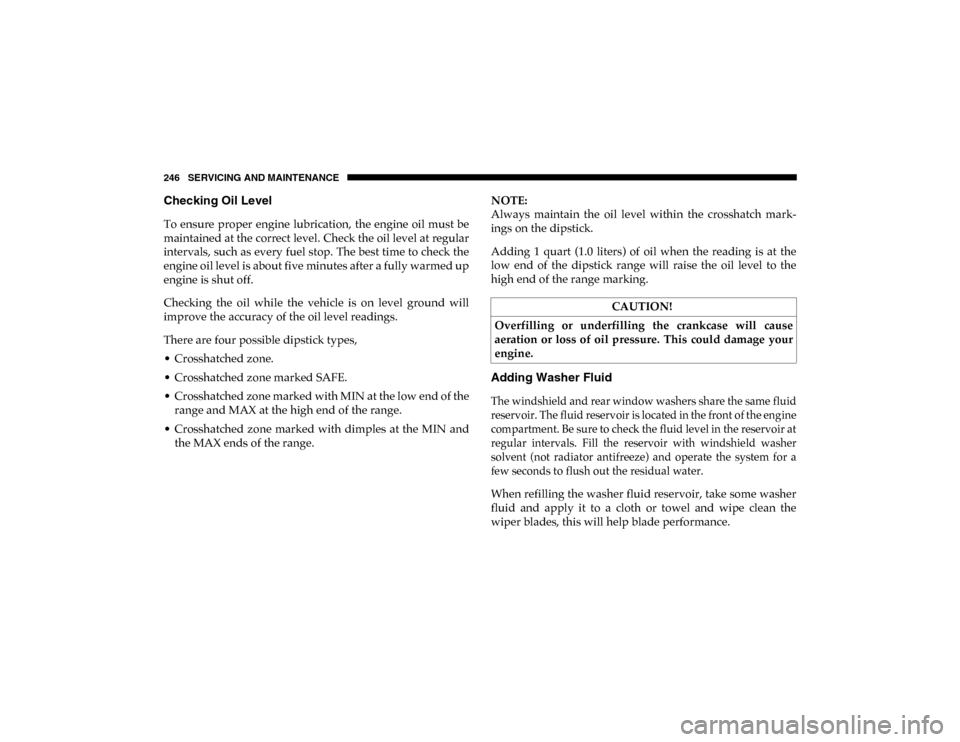
246 SERVICING AND MAINTENANCE
Checking Oil Level
To ensure proper engine lubrication, the engine oil must be
maintained at the correct level. Check the oil level at regular
intervals, such as every fuel stop. The best time to check the
engine oil level is about five minutes after a fully warmed up
engine is shut off.
Checking the oil while the vehicle is on level ground will
improve the accuracy of the oil level readings.
There are four possible dipstick types,
• Crosshatched zone.
• Crosshatched zone marked SAFE.
• Crosshatched zone marked with MIN at the low end of therange and MAX at the high end of the range.
• Crosshatched zone marked with dimples at the MIN and the MAX ends of the range. NOTE:
Always maintain the oil level within the crosshatch mark
-
ings on the dipstick.
Adding 1 quart (1.0 liters) of oil when the reading is at the
low end of the dipstick range will raise the oil level to the
high end of the range marking.
Adding Washer Fluid
The windshield and rear window washers share the same fluid
reservoir. The fluid reservoir is located in the front of the engine
compartment. Be sure to check the fluid level in the reservoir at
regular intervals. Fill the reservoir with windshield washer
solvent (not radiator antifreeze) and operate the system for a
few seconds to flush out the residual water.
When refilling the washer fluid reservoir, take some washer
fluid and apply it to a cloth or towel and wipe clean the
wiper blades, this will help blade performance. CAUTION!
Overfilling or underfilling the crankcase will cause
aeration or loss of oil pressure. This could damage your
engine.
2020_RAM_PROMASTER_CITY_OM_USA=GUID-7B6A7FCA-79B0-423F-95C5-ED2A949C3D13=1=en=.book Page 246
Page 258 of 350
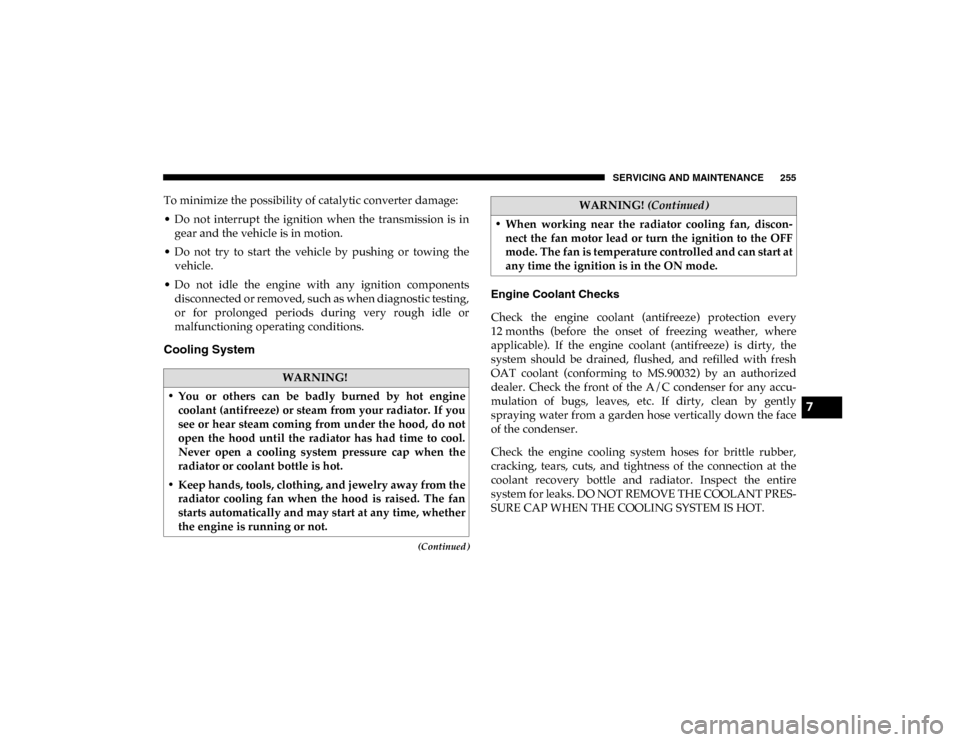
SERVICING AND MAINTENANCE 255
(Continued)
To minimize the possibility of catalytic converter damage:
• Do not interrupt the ignition when the transmission is ingear and the vehicle is in motion.
• Do not try to start the vehicle by pushing or towing the vehicle.
• Do not idle the engine with any ignition components disconnected or removed, such as when diagnostic testing,
or for prolonged periods during very rough idle or
malfunctioning operating conditions.
Cooling System
Engine Coolant Checks
Check the engine coolant (antifreeze) protection every
12 months (before the onset of freezing weather, where
applicable). If the engine coolant (antifreeze) is dirty, the
system should be drained, flushed, and refilled with fresh
OAT coolant (conforming to MS.90032) by an authorized
dealer. Check the front of the A/C condenser for any accu-
mulation of bugs, leaves, etc. If dirty, clean by gently
spraying water from a garden hose vertically down the face
of the condenser.
Check the engine cooling system hoses for brittle rubber,
cracking, tears, cuts, and tightness of the connection at the
coolant recovery bottle and radiator. Inspect the entire
system for leaks. DO NOT REMOVE THE COOLANT PRES -
SURE CAP WHEN THE COOLING SYSTEM IS HOT.
WARNING!
• You or others can be badly burned by hot engine coolant (antifreeze) or steam from your radiator. If you
see or hear steam coming from under the hood, do not
open the hood until the radiator has had time to cool.
Never open a cooling system pressure cap when the
radiator or coolant bottle is hot.
• Keep hands, tools, clothing, and jewelry away from the radiator cooling fan when the hood is raised. The fan
starts automatically and may start at any time, whether
the engine is running or not.
• When working near the radiator cooling fan, discon -
nect the fan motor lead or turn the ignition to the OFF
mode. The fan is temperature controlled and can start at
any time the ignition is in the ON mode.
WARNING! (Continued)
7
2020_RAM_PROMASTER_CITY_OM_USA=GUID-7B6A7FCA-79B0-423F-95C5-ED2A949C3D13=1=en=.book Page 255
Page 261 of 350
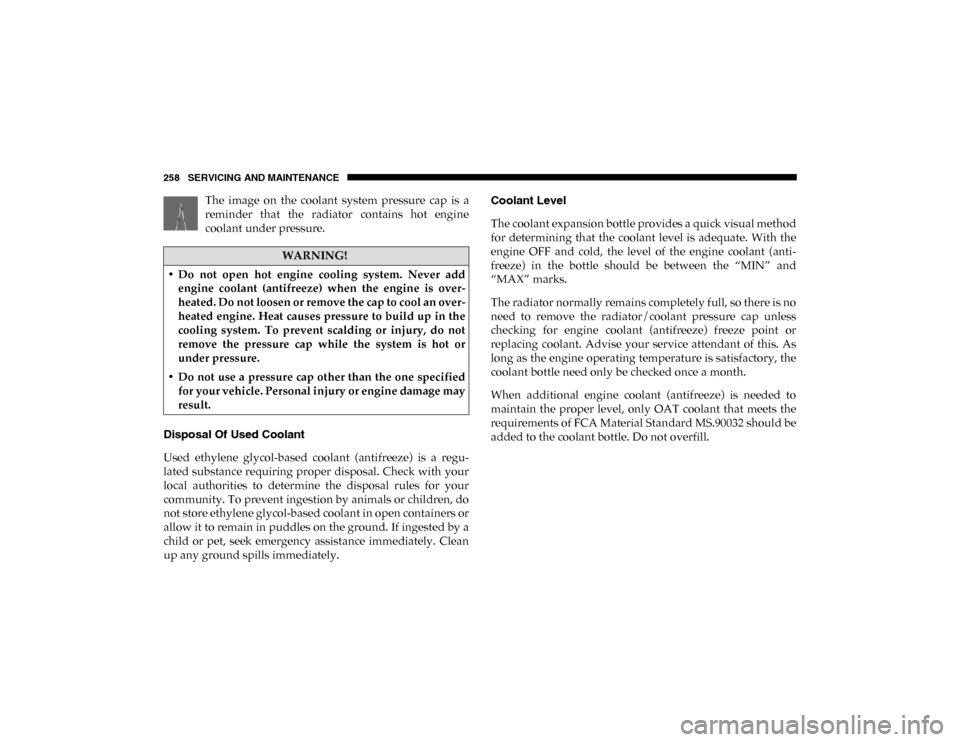
258 SERVICING AND MAINTENANCE
The image on the coolant system pressure cap is a
reminder that the radiator contains hot engine
coolant under pressure.
Disposal Of Used Coolant
Used ethylene glycol-based coolant (antifreeze) is a regu-
lated substance requiring proper disposal. Check with your
local authorities to determine the disposal rules for your
community. To prevent ingestion by animals or children, do
not store ethylene glycol-based coolant in open containers or
allow it to remain in puddles on the ground. If ingested by a
child or pet, seek emergency assistance immediately. Clean
up any ground spills immediately. Coolant Level
The coolant expansion bottle provides a quick visual method
for determining that the coolant level is adequate. With the
engine OFF and cold, the level of the engine coolant (anti
-
freeze) in the bottle should be between the “MIN” and
“MAX” marks.
The radiator normally remains completely full, so there is no
need to remove the radiator/coolant pressure cap unless
checking for engine coolant (antifreeze) freeze point or
replacing coolant. Advise your service attendant of this. As
long as the engine operating temperature is satisfactory, the
coolant bottle need only be checked once a month.
When additional engine coolant (antifreeze) is needed to
maintain the proper level, only OAT coolant that meets the
requirements of FCA Material Standard MS.90032 should be
added to the coolant bottle. Do not overfill.
WARNING!
• Do not open hot engine cooling system. Never add engine coolant (antifreeze) when the engine is over -
heated. Do not loosen or remove the cap to cool an over -
heated engine. Heat causes pressure to build up in the
cooling system. To prevent scalding or injury, do not
remove the pressure cap while the system is hot or
under pressure.
• Do not use a pressure cap other than the one specified for your vehicle. Personal injury or engine damage may
result.
2020_RAM_PROMASTER_CITY_OM_USA=GUID-7B6A7FCA-79B0-423F-95C5-ED2A949C3D13=1=en=.book Page 258
Page 262 of 350
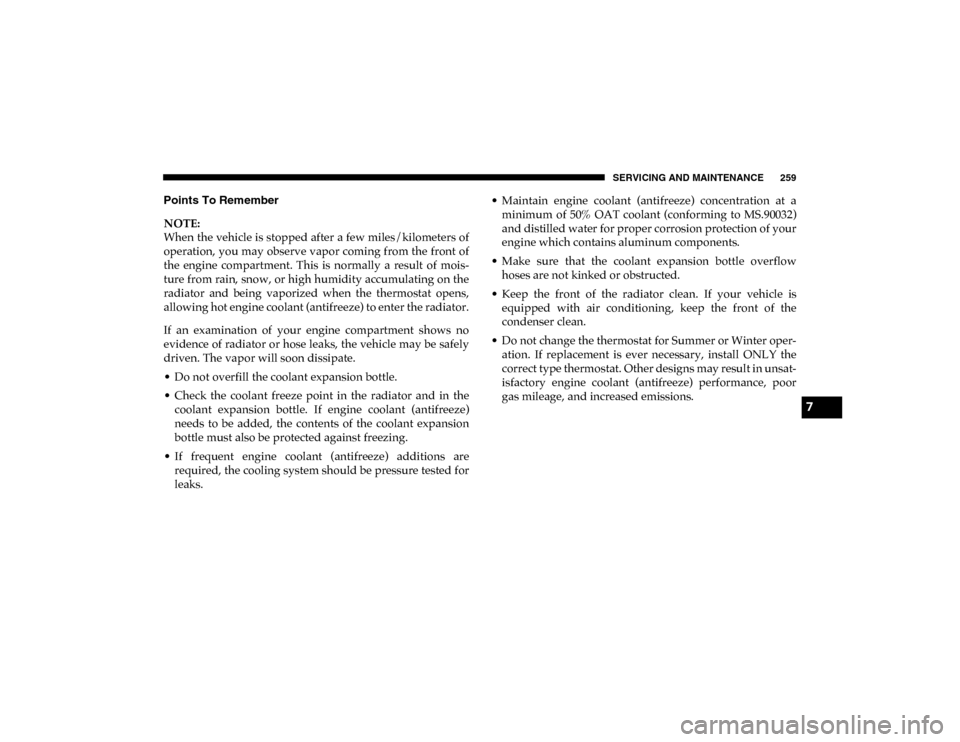
SERVICING AND MAINTENANCE 259
Points To Remember
NOTE:
When the vehicle is stopped after a few miles/kilometers of
operation, you may observe vapor coming from the front of
the engine compartment. This is normally a result of mois-
ture from rain, snow, or high humidity accumulating on the
radiator and being vaporized when the thermostat opens,
allowing hot engine coolant (antifreeze) to enter the radiator.
If an examination of your engine compartment shows no
evidence of radiator or hose leaks, the vehicle may be safely
driven. The vapor will soon dissipate.
• Do not overfill the coolant expansion bottle.
• Check the coolant freeze point in the radiator and in the coolant expansion bottle. If engine coolant (antifreeze)
needs to be added, the contents of the coolant expansion
bottle must also be protected against freezing.
• If frequent engine coolant (antifreeze) additions are required, the cooling system should be pressure tested for
leaks. • Maintain engine coolant (antifreeze) concentration at a
minimum of 50% OAT coolant (conforming to MS.90032)
and distilled water for proper corrosion protection of your
engine which contains aluminum components.
• Make sure that the coolant expansion bottle overflow hoses are not kinked or obstructed.
• Keep the front of the radiator clean. If your vehicle is equipped with air conditioning, keep the front of the
condenser clean.
• Do not change the thermostat for Summer or Winter oper -
ation. If replacement is ever necessary, install ONLY the
correct type thermostat. Other designs may result in unsat -
isfactory engine coolant (antifreeze) performance, poor
gas mileage, and increased emissions.
7
2020_RAM_PROMASTER_CITY_OM_USA=GUID-7B6A7FCA-79B0-423F-95C5-ED2A949C3D13=1=en=.book Page 259
Page 264 of 350
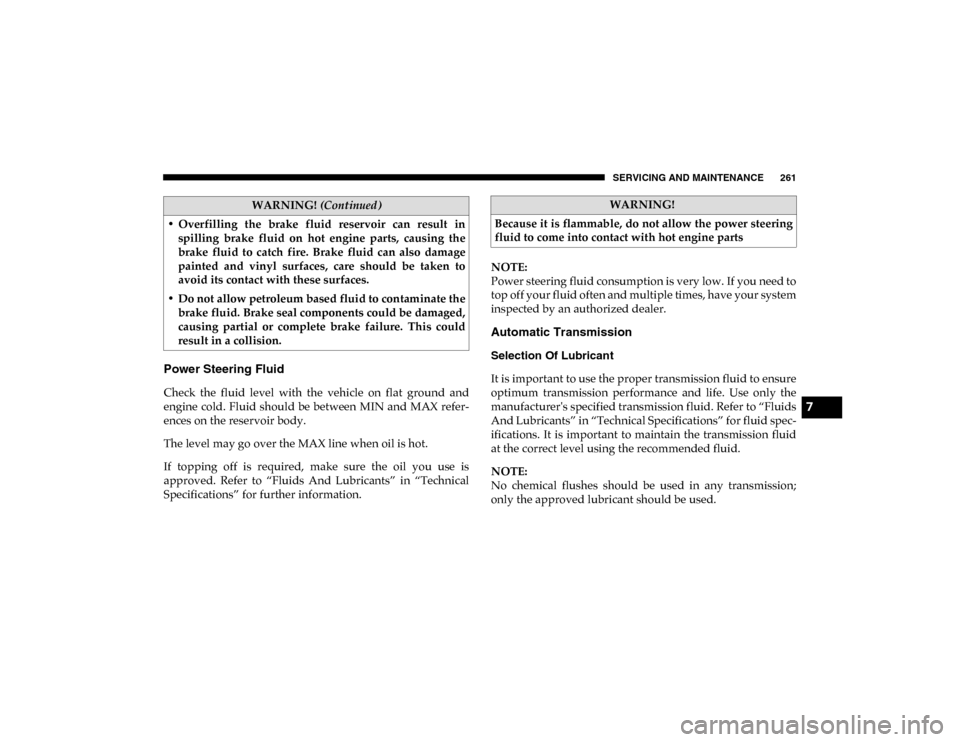
SERVICING AND MAINTENANCE 261
Power Steering Fluid
Check the fluid level with the vehicle on flat ground and
engine cold. Fluid should be between MIN and MAX refer-
ences on the reservoir body.
The level may go over the MAX line when oil is hot.
If topping off is required, make sure the oil you use is
approved. Refer to “Fluids And Lubricants” in “Technical
Specifications” for further information. NOTE:
Power steering fluid consumption is very low. If you need to
top off your fluid often and multiple times, have your system
inspected by an authorized dealer.
Automatic Transmission
Selection Of Lubricant
It is important to use the proper transmission fluid to ensure
optimum transmission performance and life. Use only the
manufacturer's specified transmission fluid. Refer to “Fluids
And Lubricants” in “Technical Specifications” for fluid spec
-
ifications. It is important to maintain the transmission fluid
at the correct level using the recommended fluid.
NOTE:
No chemical flushes should be used in any transmission;
only the approved lubricant should be used.
• Overfilling the brake fluid reservoir can result in
spilling brake fluid on hot engine parts, causing the
brake fluid to catch fire. Brake fluid can also damage
painted and vinyl surfaces, care should be taken to
avoid its contact with these surfaces.
• Do not allow petroleum based fluid to contaminate the brake fluid. Brake seal components could be damaged,
causing partial or complete brake failure. This could
result in a collision.
WARNING! (Continued)WARNING!
Because it is flammable, do not allow the power steering
fluid to come into contact with hot engine parts
7
2020_RAM_PROMASTER_CITY_OM_USA=GUID-7B6A7FCA-79B0-423F-95C5-ED2A949C3D13=1=en=.book Page 261
Page 265 of 350

262 SERVICING AND MAINTENANCE
Special Additives
The manufacturer strongly recommends against using any
special additives in the transmission. Automatic Transmis-
sion Fluid (ATF) is an engineered product and its perfor -
mance may be impaired by supplemental additives.
Therefore, do not add any fluid additives to the transmis -
sion. Avoid using transmission sealers as they may
adversely affect seals. Fluid Level Check
The fluid level is preset at the factory and does not require
adjustment under normal operating conditions. Routine
fluid level checks are not required; therefore the transmis
-
sion has no dipstick. An authorized dealer can check your
transmission fluid level using special service tools. If you
notice fluid leakage or transmission malfunction, visit an
authorized dealer immediately to have the transmission
fluid level checked. Operating the vehicle with an improper
fluid level can cause severe transmission damage.
CAUTION!
Using a transmission fluid other than the manufacturer’s
recommended fluid may cause deterioration in
transmission shift quality and/or torque converter
shudder. Refer to “Fluids And Lubricants” in “Technical
Specifications” for fluid specifications.
CAUTION!
Do not use chemical flushes in your transmission as the
chemicals can damage your transmission components.
Such damage is not covered by the New Vehicle Limited
Warranty.
CAUTION!
If a transmission fluid leak occurs, visit an authorized
dealer immediately. Severe transmission damage may
occur. An authorized dealer has the proper tools to adjust
the fluid level accurately.
2020_RAM_PROMASTER_CITY_OM_USA=GUID-7B6A7FCA-79B0-423F-95C5-ED2A949C3D13=1=en=.book Page 262
Page 338 of 350

335
INDEX
A
Adding Engine Coolant (Antifreeze) ................................... 256
Additives, Fuel ........................................................................ 299
Air Bag Air Bag Operation ............................................................... 124Driver Knee Air Bag ........................................................... 125
Enhanced Accident Response ................................... 131, 240
Event Data Recorder (EDR) ............................................... 240
Front Air Bag ....................................................................... 122If Deployment Occurs ........................................................ 130
Knee Impact Bolsters .......................................................... 124Maintaining Your Air Bag System.................................... 132
Maintenance......................................................................... 132
Transporting Pets ................................................................ 153
Air Bag Light ..................................................................... 84, 154
Air Cleaner, Engine (Engine Air Cleaner Filter) ................ 250
Air Conditioner Maintenance ............................................... 251
Air Conditioner Refrigerant .................................................. 251
Air Conditioner System ......................................................... 251
Air Conditioning Filter ............................................................ 59
Air Conditioning, Operating Tips .................................... 57, 59 Air Filter ................................................................................... 250 Air Pressure
Tires .......................................................................................277
Alarm Security Alarm .......................................................................21
Alterations/Modifications Vehicle.....................................................................................12
Antifreeze (Engine Coolant) ..........................................256, 301 Disposal ................................................................................258
Anti-Lock Brake System (ABS) ...............................................97 Anti-Lock Warning Light.........................................................88
Assist, Hill Start .......................................................................101
Audio Systems (Radio)........................................................... 305
Auto Down Power Windows ..................................................61
Auto Up Power Windows .......................................................61Automatic Transmission ................................................163, 164 Adding Fluid................................................................263, 304
Fluid And Filter Change ....................................................263
Fluid Change........................................................................263Fluid Level Check........................................................261, 262
Fluid Type ....................................................................261, 304
Special Additives .................................................................262
Auxiliary Electrical Outlet (Power Outlet) ............................70
Axle Fluid .................................................................................304
11
2020_RAM_PROMASTER_CITY_OM_USA=GUID-7B6A7FCA-79B0-423F-95C5-ED2A949C3D13=1=en=.book Page 335